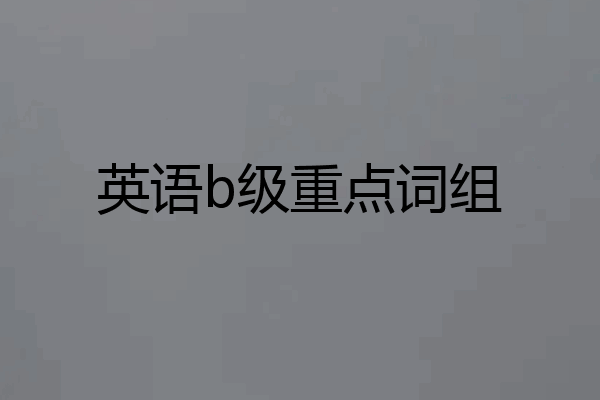
泰迪熊Teddy
英语B级考试的重要性不言而喻。有哪些重要的知识点呢? 下面我给你分享英语b级考试的知识点,欢迎阅读。
冠词是一种虚词,用在名词前面,说明名词是特指还是泛指。冠词分不定冠词和定冠词。 1. 不定冠词: a / an表示“一”、“某一”概念,用于单数可数名词前。a用在辅音开头的词前,an用在元音开头的词前。如:
an English teacher/ a second year一位老师/又一年; 2. 定冠词:the表示“特指的一个或一些”。通常用在形容词最高级及序数词前,或世界上独一无二的事物前;也用于乐器名词前。如:
the best season最好的季节/the first lady第一夫人/the earth 地球/play the piano 弹钢琴; 3. 不使用冠词的情况:在三餐饭、 球类运动 和娱乐活动的名称之前。在某些惯用词中也不用冠词,以具体名词表示抽象概念。 如:
have lunch吃午饭/ play basketball打 篮球 / go to school上学
名词可分为可数名词和不可数名词。可数名词有单、复数之分。
1.不可数名词只用单数形式。如果要表示数量多少,需在其前面加量词来表达。如:a piece of news(一条新闻);two pieces of advice(两条建议) 2.名词所有格的构成是名词加“’s”,如:Mary’s room;如原词已有复数词尾-s,则只加“’”,如:the students’ hall, 通常用于有生命的存在物的名词;名词所有格也可以由介词of加名词构成,通常用于无生命的存在物的名词, 如:the window of the classroom.
数词分为两大类:基数词和序数词。 1.基数次表示数量(one, two, three„),序数次表示次序(first, second, third„)。
2.数词hundred, thousand, million不用复数;其“复数+of”可表示数百、数千、数百万,如:three thousand 三千/ thousands of trees(数千棵树) 3.在表达年龄时,注意以下表达法:
He is six years old.(其中year须用其复数) He is a six-year-old boy.(其中year不用复数)“他6岁了。”
代词用于指代。包括:人称、物主、反身、疑问、不定代词等。
1.many, few和a few一般只能修饰或指代可数名词,much, little和a little 一般只能修饰或指代不可数名词。a few 和a little表示“有一些”,具有肯定意义,而few和little表示“几乎没有”,具有否定意义。many和much表示“许多”。 2.表示“全部”:两者用both,三者以上用all; 表示“全无”:两者用neither,三者以上用none或no one; 表示“任一”:两者用either,三者以上用any。 3.other, others, the other, the others, another的区别
(1)other作形容词修饰名词,泛指“别的、其他的”。有时会放在some, any, every, no等词
之后。e.g. We study Chinese, maths, English and other lessons. (2)others是代词,泛指“其他人或物”。如:I'm glad to help others. (3)the other特指范围内的另一个(范围内一共两个)。
e.g. I have two friends. One is from Australia, the other is from Japan. (4)the others特指范围内的另一些(范围总数通常多于两个)。
e.g. There are forty students in our class. Twenty-eight of us are boys, the others are girls. (5)another指同类中(三个或三个以上)的“另一个”,是指不确定的另一个。
e.g. Would you like another cup of coffee?
(1)绝大多数单音节和部分双音节词后加-er构成比较级,加-est构成最高级。如:
nice – nicer – nicest
(2)大部分双音节词和所有的多音节词,前面加more构成比较级,加the most 构成最高
级。如:careful-more careful-most careful 2.形容词和副词的应用 (1)同等程度比较:
as + 原级 + as e.g. Tom is as bright as Mark.汤姆和亨利一样聪明。 (2)不同程度的比较:
比较级 + than e.g. Tom is taller than Mark.汤姆比亨利高。
not as/so + 原级 + as e.g. Tom is not as/so bright as Mark.汤姆不如亨利聪明。 (3)对比与比较:
the +比较级, the +比较级 e.g. The older I get, the happier I am.我越变老,越觉得幸福。 比较级+ and +比较级 e.g. Jane became more and more beautiful.珍妮越来越漂亮了。 (4)当几个形容词修饰一个名词时,其排列顺序是:
好坏、美丑 + 大小、新旧、颜色 + 质地、属性 + 名词 e.g. a beautiful big blue wooden house


麦生啤酒
大学英语b级考试中,掌握哪些英语语法比较实用?下面是我给大家整理的英语b级语法,供大家参阅! 英语b级语法:名词 A. 知识要点 名词可分为可数名词和不可数名词。可数名词有单、复数之分。 1.不可数名词只用单数形式。如果要表示数量多少,需在其前面加量词来表达。如:a piece of news(一条新闻);two pieces of advice(两条建议) 2.名词所有格的构成是名词加“’s”,如:Mary’s room;如原词已有复数词尾-s,则只加“’”,如:the students’ hall, 通常用于有生命的存在物的名词;名词所有格也可以由介词of加名词构成,通常用于无生命的存在物的名词, 如:the window of the classroom. B.例题讲解 What a beautiful house! Especially there are many ______. A. furniture B. furnitures C. pieces of furniture D. pieces of furnitures 解析:此题考查名词的单复数。Furniture 为不可数名词,后面不能加s。很多家具用many pieces of furniture,因此答案为C。 英语b级语法:代词 代词用于指代。包括:人称、物主、反身、疑问、不定代词等。 1.many, few和a few一般只能修饰或指代可数名词,much, little和a little 一般只能修饰或指代不可数名词。a few 和a little表示“有一些”,具有肯定意义,而few和little表示“几乎没有”,具有否定意义。many和much表示“许多”。 2.表示“全部”:两者用both,三者以上用all; 表示“全无”:两者用neither,三者以上用none或no one; 表示“任一”:两者用either,三者以上用any。 3.other, others, the other, the others, another的区别 (1)other作形容词修饰名词,泛指“别的、其他的”。有时会放在some, any, every, no等词之后。e.g. We study Chinese, maths, English and other lessons. (2)others是代词,泛指“其他人或物”。如:I'm glad to help others. (3)the other特指范围内的另一个(范围内一共两个)。One„„the other e.g. I have two friends. One is from Australia, the other is from Japan. (4)the others特指范围内的另一些(范围总数通常多于两个)。 e.g. There are forty students in our class. Twenty-eight of us are boys, the others are girls. (5)another指同类中(三个或三个以上)的“另一个”,是指其中不确定的另一个。 e.g. Would you like another cup of coffee? B.例题讲解 1)The baby is hungry, but there’s ______ milk in the bottle. (《大学英语》(B)Test 2, 28) A. little B. a little C. few D. a few 解析:A。milk是不可数名词,所以只能用little/a little修饰,而根据题意“宝宝饿了,但瓶里几乎没有牛奶了”,只能选little。 2)She has two best friends. ______ of them is in the country. (《大学英语》(B)Test 2, 44) A. All B. Both C. No one D. Neither 解析:D。代词all表“所有”和both表“两者都”,其后的谓语动词需要用复数。neither表“两者都不”,其后的谓语动词用单数。 3)—It’s time to tidy your room, Harry! (《大学英语》(B)Test 5, 33) —See the tidy room, Mum! _______ is where it should be. Test 5 A. Something B. Anything C. Everything D. Nothing 解析:C。根据说话人所说内容可以知道,房间里一切都很整洁,含有整体性,应用everything。Anything主要用于疑问句和否定句中。 4)The red flower goes from one to _______ in the class. (《大学英语》(B)Test 6, 27) A. the other B. others C. another D. other 解析:C。按照句意传花不是两者之间(from one to the other),而是三者以上(from one to another),故选C。 英语b级语法:冠词 A. 知识要点 冠词是一种虚词,用在名词前面,说明名词是特指还是泛指。冠词分不定冠词和定冠词。 1. 不定冠词: a / an表示“一”、“某一”概念,用于单数可数名词前。a用在辅音开头的词前,an用在元音开头的词前。如: an English teacher/ a second year一位老师/又一年; 2. 定冠词:the表示“特指的一个或一些”。通常用在形容词最高级及序数词前,或世界上独一无二的事物前;也用于乐器名词前。如: the best season最好的季节/the first lady第一夫人/the earth 地球/play the piano 弹钢琴; 3. 不使用冠词的情况:在三餐饭、 球类运动 和娱乐活动的名称之前。在某些惯用词中也不用冠词,以具体名词表示抽象概念。 如: have lunch吃午饭/ play basketball打 篮球 / go to school上学 B.例题讲解 1)______ girl dressed ______ black is her sister Rose. (《大学英语》(B)Test 2, 34) A. A; in B. A; on C. The; on D. The; in 解析:D。介词in可表示“穿(戴)”的意思。此外,特指“穿黑色衣服的女孩”, 用定冠词the. 2)He is fond of playing _______ piano while his brother is interested in listening to _______ music. (《大学英语》(B)Test 5, 36) A. /; the B. /; / C. the; / D. the; the 解析:C。演奏的乐器名词前+the。Music为不可数名词,其前不可用a/an,而题意“对音乐感兴趣”并没有特指哪种音乐,也不可用the. 3)He goes to ______ church every Sunday. ______ church he usually goes to has seating for over a thousand. A. a, the B. /, The C. The, the D. /, a 解析:B。go to church“做礼拜”是惯用法,不用冠词。“他常去的教堂”表特指,前加the。 英语b级语法:数词 A. 知识要点 数词分为两大类:基数词和序数词。 1.基数次表示数量(one, two, three„),序数次表示次序(first, second, third„)。 2.数词hundred, thousand, million不用复数;其“复数+of”可表示数百、数千、数百万,如:three thousand 三千/ thousands of trees(数千棵树) 3.在表达年龄时,注意以下表达法: He is six years old.(其中year须用其复数) He is a six-year-old boy.(其中year不用复数)“他6岁了。”横线连接时不需要在其后加“s”。 B.例题讲解 1)They have learned about ______ in recent years. (《大学英语》(B)Test 2, 37) A. several hundreds English words B. hundreds of English words C. hundred of English words D. several hundred English word 解析:B。hundreds of 之类的 短语 之前也可加many,several之类的词修饰。A项的错误在于hundreds后缺少of。 2)Nancy is ______ girl. (《大学英语》(B)Test 2, 29) A. a eighteen-year-old B. an eighteen-years-old C. a eighteen-years-old D. an eighteen-year-old 解析:D。eighteen-year-old是一个由连字符连接的复合形容词(其中year不用复数),作girl的定语。同时,由于eighteen是元音开头的词,前面的不定冠词用an。
优质英语培训问答知识库